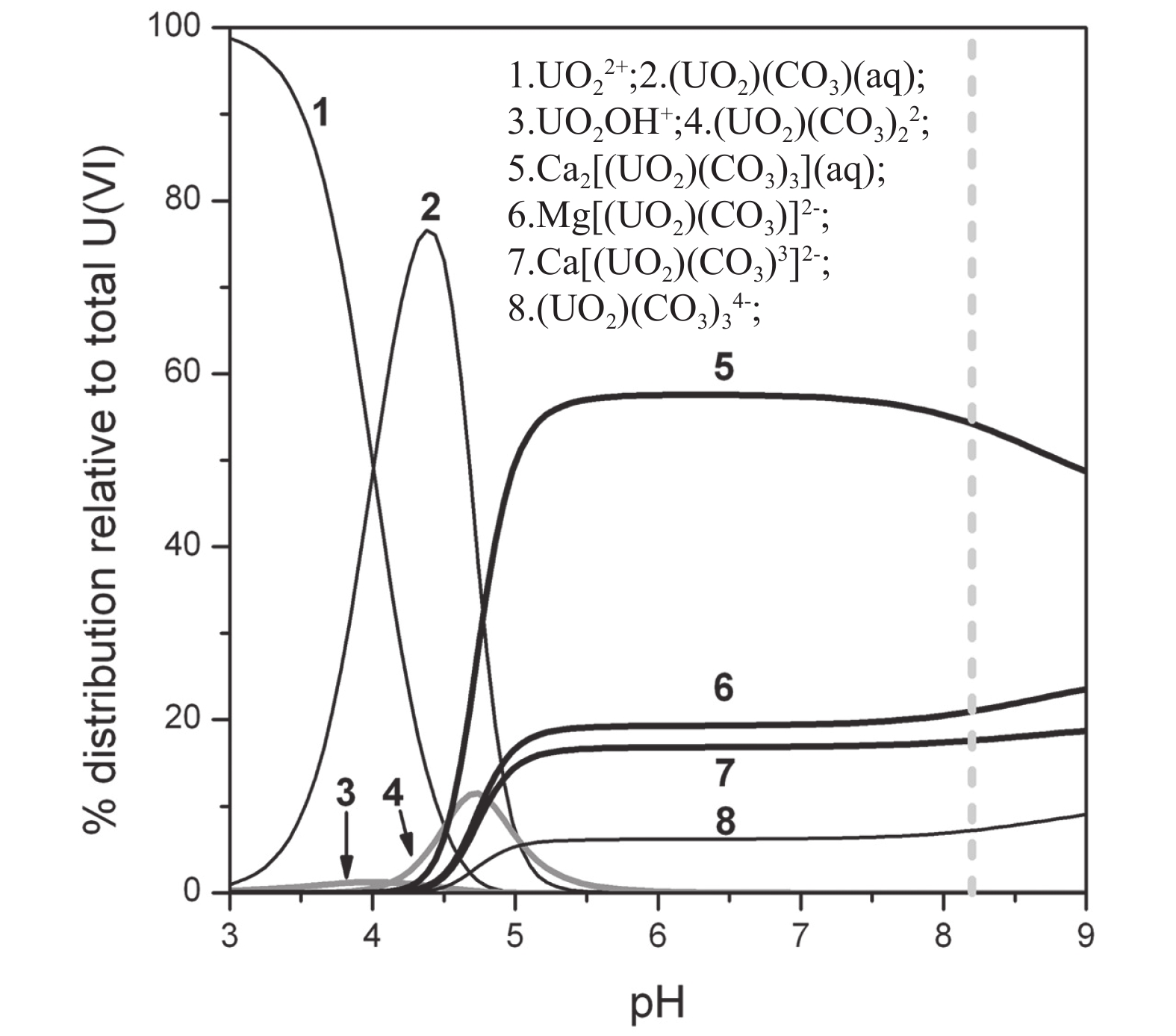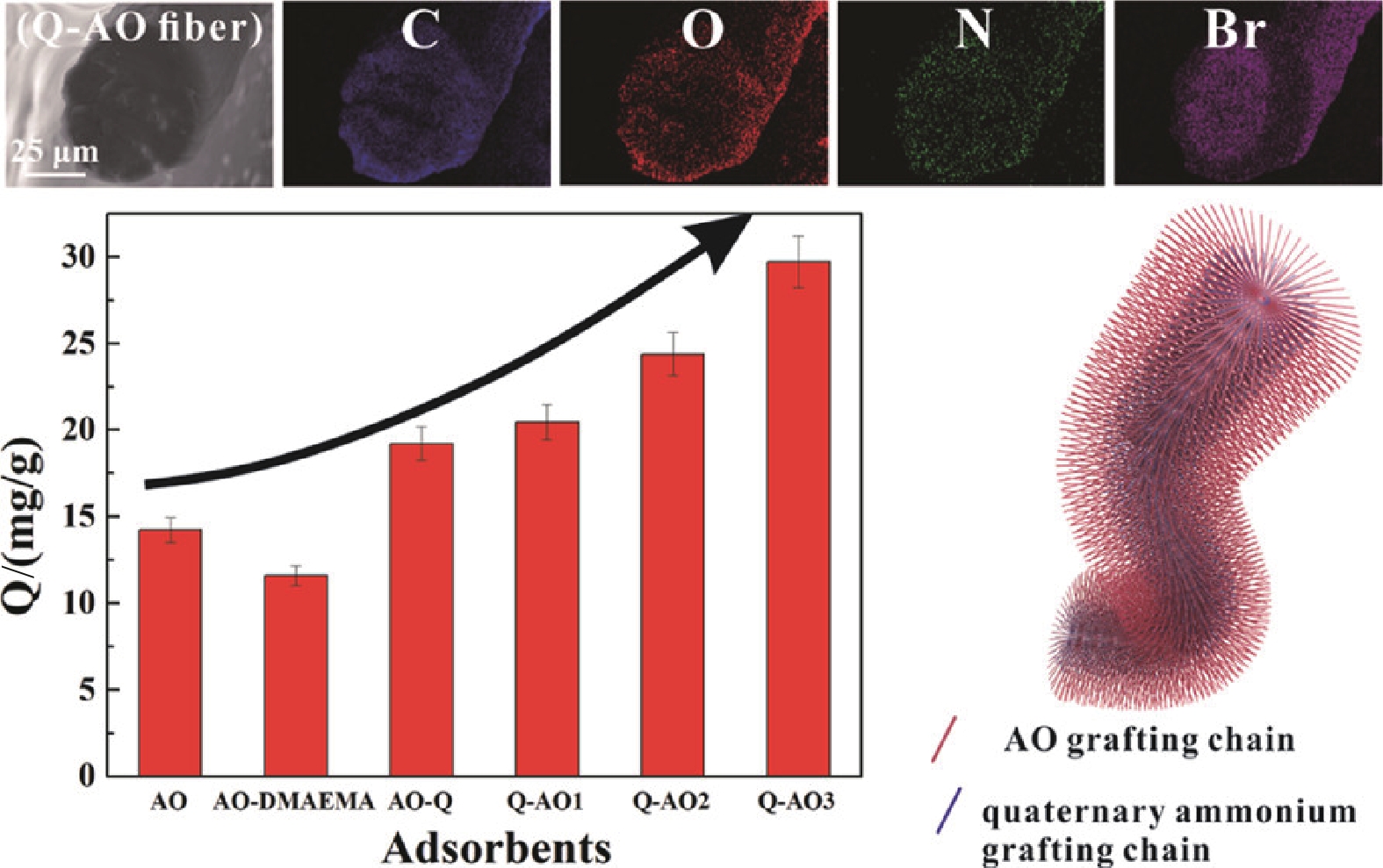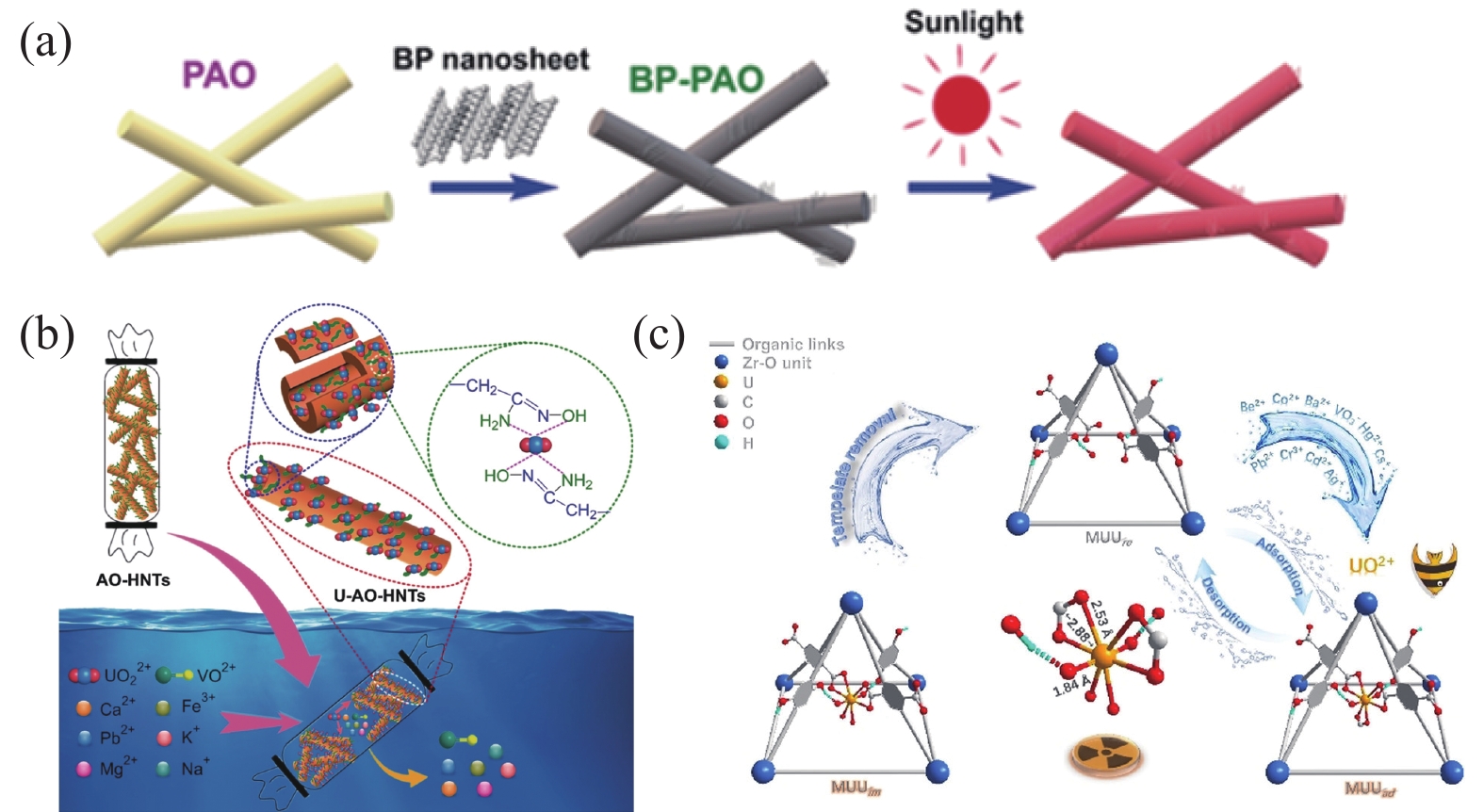2. 南方海洋科学与工程广东省实验室(广州) 滨海与深海生态环境研究中心, 广东 广州 511458
2. Research Centre of Ecology and Environment for Coastal Area and Deep Sea, Southern Marine Science and Engineering Guangdong Laboratory (Guangzhou), Guangzhou 511458, China
核能是一种高效的能源且几乎不排放温室气体,在未来能源布局和军工国防中发挥着重要作用[1-3]。铀是核燃料中的关键组分[4],在工农业、医学和地质勘探等领域也有着广泛的用途[5-6]。随着核工业的发展,铀的需求也随之剧增[7]。铀矿石八氧化三铀(U3O8)是铀目前的主要来源,在澳大利亚、哈萨克斯坦、俄罗斯分布居多[8]。根据铀红皮书数据,全球现有已探明的可采铀矿资源量约600多万吨,只够人类使用100年左右[9]。另外,陆地铀资源相对较贫乏且矿石品位比较低,不易开采。为保障核工业的长远发展,探寻开发非常规铀资源将对国家发展具有重要的战略意义[10]。海水中蕴藏着富足的化学资源,据估算海水中的铀储量高达45亿吨,是陆地上铀储量的近千倍,足够人类使用7.2万年[11]。此外,海水流动性大,相较于陆地铀矿石的开采,海水提铀对生态环境的影响小得多[12]。因此,发展海水提铀技术有望成为核工业可持续发展的关键性支撑。近年,随着铀资源需求与日俱增,海水提铀的相关研究被多个国家提升到国家战略层面。本文综述了海水提铀技术的研究进展,总结了国内外海水提铀材料特别是最具发展前景的吸附材料的研究概况、发展挑战与机遇。
1 海水提铀技术发展概况1964年,英国原子能机构Davies等[13]在《Nature》期刊公开报道了关于海水提铀的研究。2016年《Nature》刊登美国佐治亚理工学院研究者的评论,文中称海水提铀技术是7种可以改变世界的化学分离技术之一[14]。
海水的pH值约8.0~8.3,铀在这种弱碱环境下易与水中的碳酸根离子形成以三碳酸铀酰离子([UO2(CO3) 3]4-) 为主的络合物(见图1)[4,15-16]。虽然海水中铀资源储量很大,但海水提铀的真正实施仍充满挑战。首先,铀在海水中的浓度极低,仅3.3×10−6 kg/m3,远低于其他共存离子如Na+、K+等[15](见表1),因而,如何能高选择性地从海水中提取铀是技术难题之一;其次,材料必须与海水有足够大的接触面积,才能达到铀的高效提取,这需要材料有高表面活性位点;再者,吸附材料需要在海水特定pH、高盐度、竞争离子和微生物存在下仍有较好的稳定性和铀提取效果[17-19]。

|
图 1 不同pH下铀的存在形式(灰色线表示海水pH)[4] Figure 1 Existing forms of uranium in seawater at different pH (The gray line represents seawater pH) [4] |
迄今为止,海水提铀技术主要有吸附法、溶剂萃取法、离子交换法、生物处理法等[20-26]。其中,采用吸附技术来提取海水中的铀酰离子并通过脱附来实现材料的循环利用,被公认为是当前最具可行性的技术路线[27]。吸附法海水提铀的关键是开发出适应海水环境的且具备高吸附选择性、价格低廉且稳定耐用的铀吸附材料[12,18,28]。因此,相关专家和学者都致力于在新型吸附材料研发上寻求突破。目前已开发的吸附材料包含无机材料、有机材料、无机−有机杂化材料、生物质及仿生材料等[29]。本文接下来将从材料种类特性、铀吸附机制、技术瓶颈等几个方面来介绍相关研究趋势和发展展望。
2 海水提铀吸附材料 2.1 无机吸附材料无机类吸附材料具有制备工艺简单、吸附速率高、易洗脱等优势。金属氧化物由于其具有高比表面积和高孔隙率,一直是海水提铀无机吸附材料的研究热点,水合氧化钛就是代表例之一。1980年,Yamashita课题组[30]制备出水合氧化钛将其用于海水中铀的提取,研究揭示其铀吸附机制是基于水合氧化钛表面的羟基与铀酰离子的络合作用[11]。然而,金属氧化物在使用过程中极易受外界温度、pH等环境因素影响且吸附选择性仍有待提高,限制了其广泛应用。
由于纳米材料具有高比表面积等特性,可以有效增加材料与铀酰离子的接触位点,进而提升吸附容量。近年来,国内外学者开发了很多海水提铀无机纳米材料,如纳米零价铁、黑磷纳米片以及磷化硼纳米片等。Li等[31]采用硼氢化钠还原氯化铁制备了纳米零价铁,由于其较大的表面活性,能有效吸附铀且能去除水中的污染物。此外,研究人员还开发了多孔碳、氮化碳、介孔二氧化硅等无机吸附材料[32-38]。Liu等[36]合成了一种三嗪基氮化碳材料,这种铀吸附材料比传统氮化碳具有更高的比表面积,使得铀吸附性能提高了10倍。Li等[38]通过纤维素与氧化铁反应制备了铁/碳复合材料,基于材料中含氧基团和碳本身对铀的吸附作用,以及零价铁对铀的还原,该材料展现出良好的铀吸附稳定性。
尽管目前已开展了大量针对海水提铀无机类吸附材料的研究,也开发出一些性能优异的材料,但无机材料容易与其他共存离子形成络合物,导致其铀吸附选择性差。此外,无机材料还存在稳定性差、回收较困难、成本高等缺点,也限制了其在海水提铀方面的大规模应用。
2.2 有机吸附材料铀(VI) 为电子受体,因此用于铀提取的有机吸附材料主要包括含电子供体的氨基、羧基、羟基、偕胺肟基化合物等。现有研究表明,含偕胺肟基(RC(NH2) =NOH)的吸附剂对铀吸附性能优异[39],因为同时含有胺基氮和肟基氧的偕胺肟官能团与铀酰离子的配位性强,并对低浓度铀有高选择性。目前海水提铀吸附材料中最具大规模部署潜力的体系是由聚合物基体和配体基团构成的偕胺肟基聚合物吸附材料。基体提供了材料的高机械强度和高比表面积;而偕胺肟配体具有对铀的高吸附选择性和吸附效率。通常会把偕胺肟基聚合物制成螯合纤维形式,因为纤维具有高吸附活性和良好的柔性,制备的材料机械稳定性高、纤维可操作性高、易于回收利用[40],被广泛用于实际操作中。
偕胺肟化合物常通过羟胺与氰基反应获得。国内针对偕胺肟相关材料做了大量研究工作,比如通过增加材料的多孔结构,以及通过氨基、巯基、羟基与含氰基单体进行聚合来对偕胺肟聚合物进行改性,来提高铀的吸附速率和稳定性。Xu等[41]通过自组装制备了具有高比表面积的3D分层多孔偕胺肟纤维,在天然海水中达到了11.5×10−3 kg/kg的高铀吸附容量,且材料对铀的吸附能力高于其主要竞争元素钒。该纤维还展现出很高的稳定性和至少10次的吸附−解吸循环利用能力,是铀吸附材料研发的重大突破。Cheng等[42]合成了开链偕胺肟功能化的聚芳醚基共价有机骨架,其具有优异的化学稳定性和优异的结晶性,对天然海水中铀的吸附能力高达5.12×10−3 kg/kg,是钒的1.61倍。Ao等[43]合成了季铵功能化偕胺肟基纤维 (见图2) ,在模拟海水中其铀吸附能力高达29.73×10−3 kg/kg,比传统偕胺肟基纤维高出108.6%。

|
图 2 季铵功能化偕胺肟基纤维及其铀吸附性能[43] Figure 2 Quaternary ammonium functionalized amidoxime based fibers and the uranium adsorption properties[43] |
然而,由于聚合物材料构象等限制,偕胺肟基吸附材料目前仍存在吸附容量低、吸附速率慢、吸附选择性差、机械强度弱等问题。未来需要从若干方面来优化其海水提铀性能:(1) 提高材料的结构稳定性,保证吸附材料在海水中的长期运行性能;(2) 提升偕胺肟官能团在材料上的负载量和利用效率,这需要从材料构象上进行设计;(3) 强化对材料铀吸附机制的理解,从材料构建上有效提升材料的吸附能力;(4) 增加材料的可重复利用率,提升其吸附效能。
2.3 无机−有机杂化吸附材料近年来,研究人员还探索了多种无机−有机杂化材料在海水提铀中的应用,发现这类材料兼具两种吸附材料的特性,展现出高铀吸附速率和吸附选择性,并且具有较好的机械强度与韧性、稳定的化学性质,为海水提铀找到了新的技术突破点(见图3)。

|
图 3 (a) BP-PAO光纤维的制造[46]; (b) 双表面偕胺肟化天然矿石及其铀吸附机理[47]; (c) 铀酰印迹纳米笼合成及铀吸附机理[56] Figure 3 (a) Fabrication of BP-PAO fibers[46]; (b) Dual-surface amidoximated natural ore and its uranium adsorption mechanism[47]; (c) Preparation of uranyl-imprinted nanocage and the uranium adsorption mechanism[56] |
该类杂化材料的一种制备思路为将有机配体基团如偕胺肟等接枝到介孔二氧化硅、多孔碳等无机基材上或将无机纳米材料负载到偕胺肟聚合物纤维上,从而获得含较高官能团负载率和高比表面积的吸附材料,以提升铀吸附能力[44-47]。Yuan等[46]将黑磷纳米片(Black Phosphorus)复合到聚丙烯酰胺肟(polyacrylamidoxime)上,制备了具有高铀吸附能力和高耐生物污染的纤维(BP-PAO)。该材料集成了光热、光电和光催化3种光诱导效应,在含细菌的天然海水中表现出高达11.76 ×10−3 kg/kg的铀吸附能力,是普通聚丙烯偕胺肟纤维的1.5倍。Zhao等[47]将偕胺肟基团化学交联到天然矿石材料双表面上,开发了一种高效吸附剂,在1个月的天然海水实验中达到9.01×10−3 kg/kg的高铀吸附含量。
此外,另一种具有代表性的杂化吸附材料是由有机配体和金属离子或团簇配位形成的有分子内孔隙的金属有机框架(Metal-organic Framework, MOF)[48-56]。由于MOF具有规则可调的多孔结构、较大的比表面积及结构多样性和可设计性等特点,使得其能够与铀酰离子有较好的配位效应,达到较大的铀吸附容量和较高的选择性[57-58]。Carboni等[50]制备了3种具有UiO-68网络拓扑结构的MOF,发现磷酰脲衍生的MOF具有稳定的多孔结构,在吸附铀酰离子方面表现优异,其吸附容量高达217×10−3 kg/kg。Liu等[51]开发出一种双MOF架构以提高MOF的铀负载含量,材料具有良好的可逆压缩性和抗脆性,在天然海水中表现出较高的选择性铀吸附能力。通过引入缺陷赋予MOF更多的结合位点,也为铀吸附剂的设计提供了新的研究思路[52]。Zhao等[54]通过控制羧酸浓度,制备了具有缺陷可调控的MOF样品,其在真实海水中28天的吸铀量为5.83×10−3 kg/kg,是钒的10.41倍,表现出优异的吸附选择性。此外,通过分子印迹技术,在合成过程中将铀酰引入MOF中,原位构建具有特定配位属性的纳米笼结构,将提升材料对铀的吸附选择性[55]。Feng等[56]将铀酰导入含羧基和羟基官能团的UiO-66 MOF中,随后将印迹的铀酰洗脱,得到具有铀酰结合空间的MOF材料。铀酰的引入改变了官能团的空间分布,并引导形成最适宜捕获铀酰的结构,其在pH为6.0时对铀的吸附最优,高达0.475 kg/kg,而在天然海水中,对铀的吸附能力也达到7.35×10−3 kg/kg,对钒的选择性提高了18.38倍且具有高重复利用性[56]。
尽管MOF材料在海水提铀中展现出巨大的潜力,但其在实际工程化应用中仍存在许多局限,如合成原料昂贵、合成条件苛刻、在强酸溶液中不稳定等,因而其相关研究还停留在实验室阶段。
2.4 生物质及仿生吸附材料生物吸附法具有吸附快、成本低和环境友好的特点,是捕获铀的一种潜在方法。一些生物质材料包括植物、细菌、真菌和其代谢产物,从虾壳、蟹壳等提取到的含有氨基和羟基吸附位点的壳聚糖,以及受生物结构启发合成的仿生材料等都已被证明具有良好的铀吸附能力[59-66]。
Yuan等[61]分离了一种贝莱斯芽孢杆菌菌株,其在实际海水中的铀固定能力达9.46×10−3 kg/kg(见图4)。Zhou等[63]设计了一种铀酰结合蛋白,该蛋白对铀酰有非常高的选择性,其铀结合选择性是其他金属离子的10000倍以上。Yang等[64]设计了一种基于微孔聚合物的分层多孔仿生膜,在天然海水运行4周后,该膜可提取高达9.03 ×10−3 kg/kg的铀。Yu等[66]受超铀酰结合蛋白与蜘蛛丝蛛丝蛋白结构相似性的启发,设计了一种具有双铀酰结合蛋白的纤维,其充分暴露的丰富铀结合位点使其在天然海水中具有极快的铀吸附速率和超高的吸附容量(17.45 ×10−3 kg/kg)。

|
图 4 贝莱斯芽孢杆菌菌株铀吸附机制示意图[61] Figure 4 Schematic diagram of the uranium adsorption mechanism of Bacillus veleis strain [61] |
生物基吸附材料具有良好的亲水性、易生物降解性等优点,但此类材料的进一步实际应用不仅需要考虑材料的高制备成本及适宜的实施方式,还需要考虑被海洋生物摄入的风险。
3 技术瓶颈与挑战 3.1 吸附材料真实吸附容量低经过研究者近60年的不懈探索和技术发展迭代,海水提铀材料的铀吸附容量已从早期的0.5×10−3 kg/kg提升了近百倍[67-68],但现有吸附材料在真实海水中的铀吸附容量仍较低,经济效能不占优势,因此未来研究重点之一在于开发在实际海水体系中仍能展现出高吸附能力的吸附材料。偕胺肟基材料由于其优异的综合铀吸附能力,仍然是海水提铀材料的研究热点。然而,这类材料普遍存在的一个问题是,由于其高分子材料构象,偕胺肟基团的负载量和利用率仍然很低。该材料上的大部分官能团不能直接接触海水,导致材料对铀的吸附潜力无法有效发挥。此外,材料对铀的吸附速度比较慢,需要较长的运行时间才能获得足够的吸附容量。长期的海上试验也将对材料的结构稳定性、抗污能力甚至海水提铀工程的经济性提出挑战。
3.2 吸附材料对铀的选择性差海洋是一个高盐度的生态系统,存在如Na+、K+、Ca2+等各种金属离子且其浓度远高于铀。在这样的竞争环境下材料对铀酰离子的络合能力会被共存离子抑制[69]。尤其是钒,它与偕胺肟基吸附剂的结合更强,是海水中铀的最强竞争对手之一,导致材料对铀的吸附能力降低[70]。因此,对材料铀吸附选择性的提升仍然是海水提铀的研究重点。近年来,已提出多种有效的策略来提高吸附剂对铀酰离子的选择性,包括利用离子印迹技术[55-56]、基于蛋白质工程的仿生配体和协同螯合技术[71]。
3.3 吸附材料的生物附着和污染问题海洋中生物种类多、体量大、繁殖快,吸附材料经过长时间吸附后,生物附着和污染是难以避免的[72]。海洋生物附着一般包括几个发展阶段[73]:调节膜的形成—微生物附着—软体生物附着—硬体生物附着。生物在材料上的附着一方面会阻碍材料上配体与铀的结合,另一方面也会降低材料的循环使用性能[74]。因此,如何提高海洋提铀材料的抗污性已成为一个亟待解决的科学问题。目前,已用于减缓生物附着的抗菌材料主要有无机纳米颗粒[75-77](如Ag、TiO2和ZnO等)和有机材料[78-79](如胍基、壳聚糖等)。此外,针对生物附着的工程化解决方案也被提出,即在不可逆生物附着形成之前完成吸附过程。通过提高材料对铀的吸附速率,在不可逆附着形成之前将材料及时从海水中回收,进行铀的脱附等工序;此外,还可以辅助水流或气流,实时去除材料表面附着的生物,从而降低生物附着对材料吸附、脱附与再生过程的影响。
3.4 吸附材料可循环利用性低在长时间的海水实验中,吸附材料能否足以稳定地耐受海洋环境的侵蚀,以及在经过数次洗脱再生后能否继续维持其结构稳定性和吸附性能,都是海水提铀大规模工程化过程中需要探究和解决的问题。从材料角度来说,海水提铀材料的重复利用次数与材料自身的机械强度和耐海洋生物污染能力等相关;从工程设计上来说,材料循环利用寿命也会受到材料的铀洗脱、再生方式的影响[80]。深入探究海洋环境效应对吸附材料性能的影响,针对性地构建结构更为稳定的海水提铀材料;通过解析离子与吸附材料的配位机制,采用相对温和的材料洗脱和再生工艺,进而提高材料在真实海水中的吸附效率和重复利用率。
4 结论与展望我国海洋铀资源储量丰富,但现阶段开发利用不足。一方面,这是受海水中铀浓度较低且海水环境复杂等因素影响,导致海水提铀材料仍无法完全满足高铀吸附的选择性和稳定性,且材料对铀酰离子的配位吸附机制尚未完全明晰,这限制了材料的定向优化设计。另一方面,目前海水提铀吸附材料的制备、运行和维护成本也较高,这也限制了海水提铀的大规模应用。针对上述问题,在吸附材料的设计和研发中,仍需开展针对铀吸附机制的基础研究,确定影响材料性能的关键要素,为吸附材料的优化设计和构筑积累基础数据;另外,要考量材料的铀吸附效能与其在海水中运行的稳定性,同时从原材料选择入手兼顾材料规模化制备可行性。将规模化放大制备作为海水提铀研发的重要环节,推动科技成果有效转化为实际产品,实现海水提铀技术从实验室研究到海上作业平台的高质量发展。此外,技术集成与耦合也将是有效提升海水提铀效率的策略之一。例如,利用膜分离技术辅助吸附,可以高效富集海水中的铀资源,从而提高吸附速率;利用海洋潮汐与洋流来增加海水与材料的接触率;借助电化学提高单一化学吸附对铀酰离子的吸附速率。从能耗入手,借助风能、盐差能、潮汐能等海上能源,探索与光驱动等技术耦合思路,降低海水提铀技术成本。综合权衡吸附能力提升与额外技术成本投入,实现对铀资源的高选择性、高提取效率和低成本操作。总之,无论是海水提铀材料还是其实际操作,要以海水提铀工程化为发展目标。加强海水提铀基础研究和科技成果转化,对于提升我国铀资源战略储备、推进核工业强国建设具有重要意义。
| [1] |
WANG S J, YUAN P, LI D, et al. An overview of ocean renewable energy in China[J].
Renewable and Sustainable Energy Reviews, 2011, 15(1): 91-111.
DOI: 10.1016/j.rser.2010.09.040. |
| [2] |
LIU C Z, RAO Z H. Challenges in various thermal energy storage technologies[J].
Science Bulletin, 2017, 62(4): 231-233.
DOI: 10.1016/j.scib.2017.01.019. |
| [3] |
PIECHOWICZ M, ABNEY C W, ZHOU X, et al. Design, synthesis, and characterization of a bifunctional chelator with ultrahigh capacity for uranium uptake from seawater simulant[J].
Industrial & Engineering Chemistry Research, 2016, 55(15): 4170-4178.
|
| [4] |
ENDRIZZI F, LEGGETT C J, RAO L F. Scientific basis for efficient extraction of uranium from seawater. I: understanding the chemical speciation of uranium under seawater conditions[J].
Industrial & Engineering Chemistry Research, 2016, 55(15): 4249-4256.
|
| [5] |
DONIA A M, ATIA A A, MOUSSA E M, et al. Removal of uranium(VI) from aqueous solutions using glycidyl methacrylate chelating resins[J].
Hydrometallurgy, 2009, 95(3-4): 183-189.
DOI: 10.1016/j.hydromet.2008.05.037. |
| [6] |
刘埃平, 钟子川. 铀的地球化学特征及其在油气勘探中的应用[J].
石油学报, 1999, 20(6): 32-37.
LIU A P, ZHONG Z C. Geochemical characteristics of uranium and the application to oil & gas exploration[J]. Acta Petrolei Sinica, 1999, 20(6): 32-37. |
| [7] |
WANG Y, WANG J J, WANG J, et al. Efficient recovery of uranium from saline lake brine through photocatalytic reduction[J].
Journal of Molecular Liquids, 2020, 308: 113007.
DOI: 10.1016/j.molliq.2020.113007. |
| [8] |
KRAKOWSKI R A. Presentations of the international conference on preparing the ground for renewal of nuclear power[M]// KURSUNOGLU B N, MINTZ S L, PERLMUTTER A, et al. Preparing the Ground for Renewal of Nuclear Power. Boston : Springer, 1999: 167-193.
|
| [9] |
The Nuclear Energy Agency and the International Atomic Energy Agency. Uranium 2020: resources, production and demand[J].
Ux Weekly, 2021, 35(2): 1-4.
|
| [10] |
熊洁, 文君, 胡胜, 等. 中国海水提铀研究进展[J].
核化学与放射化学, 2015, 37(5): 257-265.
XIONG J, WEN J, HU S, et al. Progress in extraction uranium from seawater of China[J]. Journal of Nuclear and Radiochemistry, 2015, 37(5): 257-265. |
| [11] |
李昊, 文君, 汪小琳. 中国海水提铀研究进展[J].
科学通报, 2018, 63(Z1): 481-494.
LI H, WEN J, WANG X L. Research advances on extracting uranium from seawater in China[J]. Chinese Science Bulletin, 2018, 63(Z1): 481-494. |
| [12] |
陈树森, 任宇, 丁海云, 等. 海水提铀的研究进展[J].
原子能科学技术, 2015, 49(3): 415-423.
CHEN S S, REN Y, DING H Y, et al. Research progress of extraction uranium from seawater[J]. Atomic Energy Science and Technology, 2015, 49(3): 415-423. |
| [13] |
DAVIES R V, KENNEDY J, MCILROY R W, et al. Extraction of uranium from sea water[J].
Nature, 1964, 203(4950): 1110-1115.
DOI: 10.1038/2031110a0. |
| [14] |
冯健, 何桂强, 魏艳霞, 等. 海水提铀吸附材料研究进展[J].
化工新型材料, 2022, 50(3): 1-7.
FENG J, HE G Q, WEI Y X, et al. Research progress on adsorption material for U extraction from seawater[J]. New Chemical Materials, 2022, 50(3): 1-7. |
| [15] |
TUREKIAN K K, HOLLAND H D. Treatise on geochemistry[M]. Amsterdam: Elsevier Science, 2003.
|
| [16] |
TIAN G X, TEAT S J, ZHANG Z Y, et al. Sequestering uranium from seawater: binding strength and modes of uranyl complexes with glutarimidedioxime[J].
Dalton Transactions, 2012, 41(38): 11579-11586.
DOI: 10.1039/c2dt30978e. |
| [17] |
KIM J, OYOLA Y, TSOURIS C, et al. Characterization of uranium uptake kinetics from seawater in batch and flow-through experiments[J].
Industrial & Engineering Chemistry Research, 2013, 52(27): 9433-9440.
|
| [18] |
DRYSDALE J A, BUESSEIER K O. Uranium adsorption behaviour of amidoximated fibers under coastal ocean conditions[J].
Progress in Nuclear Energy, 2020, 119: 103170.
DOI: 10.1016/j.pnucene.2019.103170. |
| [19] |
HU J T, MA H J, XING Z, et al. Preparation of amidoximated ultrahigh molecular weight polyethylene fiber by radiation grafting and uranium adsorption test[J].
Industrial & Engineering Chemistry Research, 2016, 55(15): 4118-4124.
|
| [20] |
BAI Z, LIU Q, ZHANG H, et al. Anti-biofouling and water—stable balanced charged metal organic framework-based polyelectrolyte hydrogels for extracting uranium from seawater[J].
ACS Applied Materials & Interfaces, 2020, 12(15): 18012-18022.
|
| [21] |
MA D, XU X, LI Z, et al. Nano emulsion assembly toward vaterite mesoporous CaCO3 for high-efficient uranium extraction from seawater[J].
Journal of Hazardous Materials, 2022, 432: 128695.
DOI: 10.1016/j.jhazmat.2022.128695. |
| [22] |
LIU M X, DONG F Q, YAN X Y, et al. Biosorption of uranium by saccharomyces cerevisiae and surface interactions under culture conditions[J].
Bioresource Technology, 2010, 101(22): 8573-8580.
DOI: 10.1016/j.biortech.2010.06.063. |
| [23] |
FENG M L, SARMA D, QI X H, et al. Efficient removal and recovery of uranium by a layered organic-inorganic hybrid thiostannate[J].
Journal of the American Chemical Society, 2016, 138(38): 12578-12585.
DOI: 10.1021/jacs.6b07351. |
| [24] |
LEE S, KANG U, PIAO G, et al. Homogeneous photoconversion of seawater uranium using copper and iron mixed-oxide semiconductor electrodes[J].
Applied Catalysis B:Environmental, 2017, 207: 35-41.
DOI: 10.1016/j.apcatb.2017.02.004. |
| [25] |
SODAYE H, NISAN S, POLETIKO C, et al. Extraction of uranium from the concentrated brine rejected by integrated nuclear desalination plants[J].
Desalination, 2009, 235(1-3): 9-32.
DOI: 10.1016/j.desal.2008.02.005. |
| [26] |
WANG Y, ZHANG Y, LI Q, et al. Amidoximated cellulose fiber membrane for uranium extraction from simulated seawater[J].
Carbohydrate Polymers, 2020, 245: 116627.
DOI: 10.1016/j.carbpol.2020.116627. |
| [27] |
白震媛, 许恒斌, 王君, 等. 海水提铀的最新进展[J].
黑龙江大学自然科学学报, 2020, 37(1): 61-70.
BAI Z Y, XU H B, WANG J, et al. New development of uranium extraction from sea water[J]. Journal of Natural Science of Heilongjiang University, 2020, 37(1): 61-70. |
| [28] |
金可勇, 俞三传, 高从阶. 从海水中提取铀的发展现状[J].
海洋通报, 2001, 20(2): 78-82.
JIN K Y, YU S C, GAO C J. Present situation of uranium recovery from seawater[J]. Marine Science Bulletin, 2001, 20(2): 78-82. |
| [29] |
王莹, 李倩, 曹丽霞, 等. 生物质基铀吸附材料的研究进展[J].
化工学报, 2021, 72(3): 1205-1216.
WANG Y, LI Q, CAO L X, et al. Progress of biomass-based materials for uranium adsorption[J]. CIESC Journal, 2021, 72(3): 1205-1216. |
| [30] |
YAMASHITA H, OZAWA Y, NAKAJIMA F, et al. The collection of uranium from sea water with hydrous metal oxide. II. The mechanism of uranium adsorption on hydrous titanium (IV) oxide[J].
Bulletin of the Chemical Society of Japan, 1980, 53(1): 1-5.
DOI: 10.1246/bcsj.53.1. |
| [31] |
LI X Y, ZHANG M, LIU Y B, et al. Removal of U(VI) in aqueous solution by nanoscale zero-valent iron(nZVI)[J].
Water Quality, Exposure and Health, 2013, 5(1): 31-40.
DOI: 10.1007/s12403-013-0084-4. |
| [32] |
DONG Z, ZHANG Z, ZHOU R. Construction of oxidized millimeter-sized hierarchically porous carbon spheres for U(VI) adsorption[J].
Chemical Engineering Journal, 2020, 386: 123944.
DOI: 10.1016/j.cej.2019.123944. |
| [33] |
GIANNAKOUDAKIS D A, ANASTOPOULOS I, BARCZAK M, et al. Enhanced uranium removal from acidic wastewater by phosphonate-functionalized ordered mesoporous silica: Surface chemistry matters the most[J].
Journal of Hazardous Materials, 2021, 413: 125279.
DOI: 10.1016/j.jhazmat.2021.125279. |
| [34] |
AHMAD M, WANG J Q, YANG Z T, et al. Ultrasonic-assisted preparation of amidoxime functionalized silica framework via oil-water emulsion method for selective uranium adsorption[J].
Chemical Engineering Journal, 2020, 389: 124441.
DOI: 10.1016/j.cej.2020.124441. |
| [35] |
WANG Y Q, ZHANG Z B, LIU Y H, et al. Adsorption of U(VI) from aqueous solution by the carboxyl-mesoporous carbon[J].
Chemical Engineering Journal, 2012, 198: 246-253.
|
| [36] |
LIU S, WANG Z, LU Y X, et al. Sunlight-induced uranium extraction with triazine-based carbon nitride as both photocatalyst and adsorbent[J].
Applied Catalysis B:Environmental, 2021, 282: 119523.
DOI: 10.1016/j.apcatb.2020.119523. |
| [37] |
CHEN M Q, LI S S, LI L P, et al. Memory effect induced the enhancement of uranium(VI) immobilization on low-cost MgAl-double oxide: Mechanism insight and resources recovery[J].
Journal of Hazardous Materials, 2021, 401: 123447.
DOI: 10.1016/j.jhazmat.2020.123447. |
| [38] |
LI M X, LIU H B, CHEN T H, et al. Efficient U(VI) adsorption on iron/carbon composites derived from the coupling of cellulose with iron oxides: performance and mechanism[J].
Science of the Total Environment, 2020, 703: 135604.
DOI: 10.1016/j.scitotenv.2019.135604. |
| [39] |
AGRAWAL Y K, SHRIVASTAV P, MENON S K. Solvent extraction, separation of uranium(VI) with crown ether[J].
Separation and Purification Technology, 2000, 20(2-3): 177-183.
DOI: 10.1016/S1383-5866(00)00110-6. |
| [40] |
WANG F H, LI H P, LIU Q, et al. A graphene oxide/amidoxime hydrogel for enhanced uranium capture[J].
Scientific Reports, 2016, 6(1): 19367.
DOI: 10.1038/srep19367. |
| [41] |
XU X, ZHANG H J, AO J X, et al. 3D hierarchical porous amidoxime fibers speed up uranium extraction from seawater[J].
Energy & Environmental Science, 2019, 12(6): 1979-1988.
|
| [42] |
CHENG G, ZHANG A R, ZHAO Z W, et al. Extremely stable amidoxime functionalized covalent organic frameworks for uranium extraction from seawater with high efficiency and selectivity[J].
Science Bulletin, 2021, 66(19): 1994-2001.
DOI: 10.1016/j.scib.2021.05.012. |
| [43] |
AO J X, HAN J G, XU X, et al. Enhanced performance in uranium extraction by quaternary ammonium-functionalized amidoxime-based fibers[J].
Industrial & Engineering Chemistry Research, 2020, 59(13): 5828-5837.
|
| [44] |
XU L, CHEN Y, SU W, et al. Synergistic adsorption of U(VI) from seawater by Mxene and amidoxime mixed matrix membrane with high efficiency[J].
Separation and Purification Technology., 2023, 309: 123024.
DOI: 10.1016/j.seppur.2022.123024. |
| [45] |
GÓRKA J, MAYES R T, BAGGETTO L, et al. Sonochemical functionalization of mesoporous carbon for uranium extraction from seawater[J].
Journal of Materials Chemistry A, 2013, 1(9): 3016-3026.
DOI: 10.1039/c2ta01008a. |
| [46] |
YUAN Y H, NIU B Y, YU Q H, et al. Photoinduced multiple effects to enhance uranium extraction from natural seawater by black phosphorus nanosheets[J].
Angewandte Chemie International Edition, 2020, 59(3): 1220-1227.
DOI: 10.1002/anie.201913644. |
| [47] |
ZHAO S, YUAN Y, YU Q, et al. A dual-surface amidoximated halloysite nanotube for high-efficiency economical uranium extraction from seawater[J].
Angewandte Chemie International Edition, 2019, 131(42): 15121-15127.
DOI: 10.1002/ange.201908762. |
| [48] |
YAGHI M O, LI H L. Hydrothermal synthesis of a metal-organic framework containing large rectangular channels[J].
Journal of the American Chemical Society, 2002, 117(41): 10401-10402.
|
| [49] |
朱雅静, 徐岩, 简美鹏, 等. 金属有机框架材料用于海水提铀的研究进展[J].
化工进展, 2023, 42(6): 3029-3048.
ZHU Y J, XU Y, JIAN M P, et al. Progress of metal-organic frameworks for uranium extraction from seawater[J]. Chemical Industry and Engineering Progress, 2023, 42(6): 3029-3048. |
| [50] |
CARBONI M, ABNEY C W, LIU S B, et al. Highly porous and stable metal-organic frameworks for uranium extraction[J].
Chemical Science, 2013, 4(6): 2396-2402.
DOI: 10.1039/c3sc50230a. |
| [51] |
LIU T, ZHANG X, GU A, et al. In-situ grown bilayer MOF from robust wood aerogel with aligned microchannel arrays toward selective extraction of uranium from seawater[J].
Chemical Engineering Journal, 2022, 433: 134346.
DOI: 10.1016/j.cej.2021.134346. |
| [52] |
GUTOV O V, HEVIA M G, ESCUDERO-ADAN E C, et al. Metal-Organic Framework (MOF) defects under control: insights into the missing linker sites and their implication in the reactivity of zirconium-based frameworks[J].
Inorganic Chemistry, 2015, 54(17): 8396-8400.
DOI: 10.1021/acs.inorgchem.5b01053. |
| [53] |
CHEN L, BAI Z L, ZHU L, et al. Ultrafast and efficient extraction of uranium from seawater using an amidoxime appended metal-organic framework[J].
ACS Applied Materials & Interfaces, 2017, 9(38): 32446-32451.
|
| [54] |
ZHAO Z W, LEI R C, ZHANG Y Z, et al. Defect controlled MOF-808 for seawater uranium capture with high capacity and selectivity[J].
Journal of Molecular Liquids, 2022, 367: 120514.
DOI: 10.1016/j.molliq.2022.120514. |
| [55] |
YUAN Y H, FENG S W, FENG L J, et al. A bio-inspired nano-pocket spatial structure for targeting uranyl capture[J].
Angewandte Chemie International Edition, 2020, 59(11): 4262-4268.
DOI: 10.1002/anie.201916450. |
| [56] |
FENG L J, WANG H, FENG T T, et al. In situ synthesis of uranyl-imprinted nanocage for selective uranium recovery from seawater[J].
Angewandte Chemie International Edition, 2022, 134(13): e202101015.
|
| [57] |
LIU D H, ZHONG C L. Understanding gas separation in metal-organic frameworks using computer modeling[J].
Journal of Materials Chemistry, 2010, 20(46): 10308-10318.
DOI: 10.1039/c0jm01045f. |
| [58] |
LIN Z J, LU J, HONG M C, et al. Metal-Organic Frameworks based on flexibleligands (FL-MOFs) : structures and applications[J].
Chemical Society Reviews, 2014, 43(16): 5867-5895.
DOI: 10.1039/C3CS60483G. |
| [59] |
WANG M, FENG L, LUO G, et al. Ultrafast extraction of uranium from seawater using photosensitized biohybrid system with bioinspired cascaded strategy[J].
Journal of Hazardous Materials, 2023, 445: 130620.
DOI: 10.1016/j.jhazmat.2022.130620. |
| [60] |
LI C, WANG M L, LUO X G. Uptake of uranium from aqueous solution by nymphaea tetragona georgi: the effect of the accompanying heavy metals[J].
Applied Radiation and Isotopes, 2019, 150: 157-163.
DOI: 10.1016/j.apradiso.2019.05.024. |
| [61] |
YUAN Y H, YU Q H, YANG S, et al. Ultrafast recovery of uranium from seawater by bacillus velezensis strain UUS-1 with innate anti-biofouling activity[J].
Advanced Science, 2019, 6(18): 1900961.
DOI: 10.1002/advs.201900961. |
| [62] |
HE D, TAN N, LUO X, et al. Preparation, uranium (VI) absorption and reuseability of marine fungus mycelium modified by the bis-amidoxime-based groups[J] Radiochimica Acta, 2019, 108(1) : 37-49.
|
| [63] |
ZHOU L, BOSSCHER M, ZHANG, C, et al. A protein engineered to bind uranyl selectively and with femtomolar affinity[J].
Nature Chemistry, 2014, 6: 236-241.
DOI: 10.1038/nchem.1856. |
| [64] |
YANG L, XIAO H, QIAN, Y, et al. Bioinspired hierarchical porous membrane for efficient uranium extraction from seawater[J].
Nature Sustainability, 2022, 5: 71-80.
|
| [65] |
YUAN Y H, YU Q H, WEN J, et al. Ultrafast and highly selective uranium extraction from seawater by hydrogel-like spidroin-based protein fiber[J].
Angewandte Chemie International Edition, 2019, 58(34): 11785-11790.
DOI: 10.1002/anie.201906191. |
| [66] |
YU Q H, YUAN Y H, FENG L J, et al. Spidroin-inspired, high-strength, loofah-shaped protein fiber for capturing uranium from seawater[J].
Angewandte Chemie International Edition, 2020, 59(37): 15997-16001.
DOI: 10.1002/anie.202007383. |
| [67] |
AGUILA B, SUN Q, CASSADY H, et al. Design strategies to enhance amidoxime chelators for uranium recovery[J].
ACS Applied Materials & Interfaces, 2019, 11(34): 30919-30926.
|
| [68] |
SEKO N, KATAKAI A, HASEGAWA S, et al. Aquaculture of uranium in seawater by a fabric-adsorbent submerged system[J].
Nuclear Technology, 2003, 144(2): 274-278.
DOI: 10.13182/NT03-2. |
| [69] |
LADSHAW A P, DAS S, LIAO W P, et al. Experiments and modeling of uranium uptake by amidoxime-based adsorbent in the presence of other ions in simulated seawater[J].
Industrial & Engineering Chemistry Research, 2016, 55(15): 4241-4248.
|
| [70] |
GILL G A, KUO L J, JANKE C J, et al. The uranium from seawater program at the pacific northwest national laboratory: overview of marine testing, adsorbent characterization, adsorbent durability, adsorbent toxicity, and deployment studies[J].
Industrial & Engineering Chemistry Research, 2016, 55(15): 4264-4277.
|
| [71] |
XIE Y, LIU Z Y, GENG Y Y, et al. Uranium extraction from seawater: material design, emerging technologies and marine engineering[J].
Chemical Society Reviews, 2023, 52(1): 97-162.
DOI: 10.1039/D2CS00595F. |
| [72] |
李子明, 牛玉清, 宿延涛, 等. 海水提铀技术最新研究进展[J].
核化学与放射化学, 2022, 44(3): 233-245.
LI Z M, NIU Y Q, SU Y T, et al. Latest research progress of uranium extraction from seawater[J]. Journal of Nuclear and Radiochemistry, 2022, 44(3): 233-245. |
| [73] |
LEJARS M, MARGAILLAN A, BRESSY C. Fouling release coatings: a nontoxic alternative to biocidal antifouling coatings[J].
Chemical Reviews, 2012, 112(8): 4347-4390.
DOI: 10.1021/cr200350v. |
| [74] |
PARK J, GILL G A, STRIVENS J E, et al. Effect of biofouling on the performance of amidoxime-based polymeric uranium adsorbents[J].
Industrial & Engineering Chemistry Research, 2016, 55(15): 4328-4338.
|
| [75] |
ZHU J, ZHANG H, CHEN R, et al. An anti-algae adsorbent for uranium extraction: i-arginine functionalized graphene hydrogel loaded with Ag nanoparticles[J].
Journal of Colloid and Interface Science, 2019, 543: 192-200.
DOI: 10.1016/j.jcis.2019.02.045. |
| [76] |
LI N, GAO P, CHEN H, et al, Amidoxime modified Fe304@TiO2 particles for antibacterial and efficient uranium extraction from seawater[J]. Chemosphere, 2022, 287: 132137.
|
| [77] |
MA H C, ZHANG F, LI Q Y, et al. Preparation of ZnO nanoparticle loaded amidoximated wool fibers as a promising antibiofouling adsorbent for uranium(VI) recovery[J].
RSC Advances, 2019, 9(32): 18406-18414.
DOI: 10.1039/C9RA03777B. |
| [78] |
LI H, HE N N, CHENG C, et al. Antimicrobial polymer contained adsorbent: a promising candidate with remarkable anti-biofouling ability and durability for enhanced uranium extraction from seawater[J].
Chemical Engineering Journal, 2020, 388: 124273.
DOI: 10.1016/j.cej.2020.124273. |
| [79] |
ZHANG Y, CAI T, ZHAO Z, et al. Poly (amidoxime) -graft-magnetic chitosan for highly efficient and selective uranium extraction from seawater[J].
Carbohydrate Polymers, 2023, 301: 120367.
DOI: 10.1016/j.carbpol.2022.120367. |
| [80] |
KUO L J, PAN H B, WAI C M, et al. Investigations into the reusability of amidoxime-based polymeric adsorbents for seawater uranium extraction[J].
Industrial & Engineering Chemistry Research, 2017, 56(40): 11603-11611.
|
 2023, Vol. 40
2023, Vol. 40

